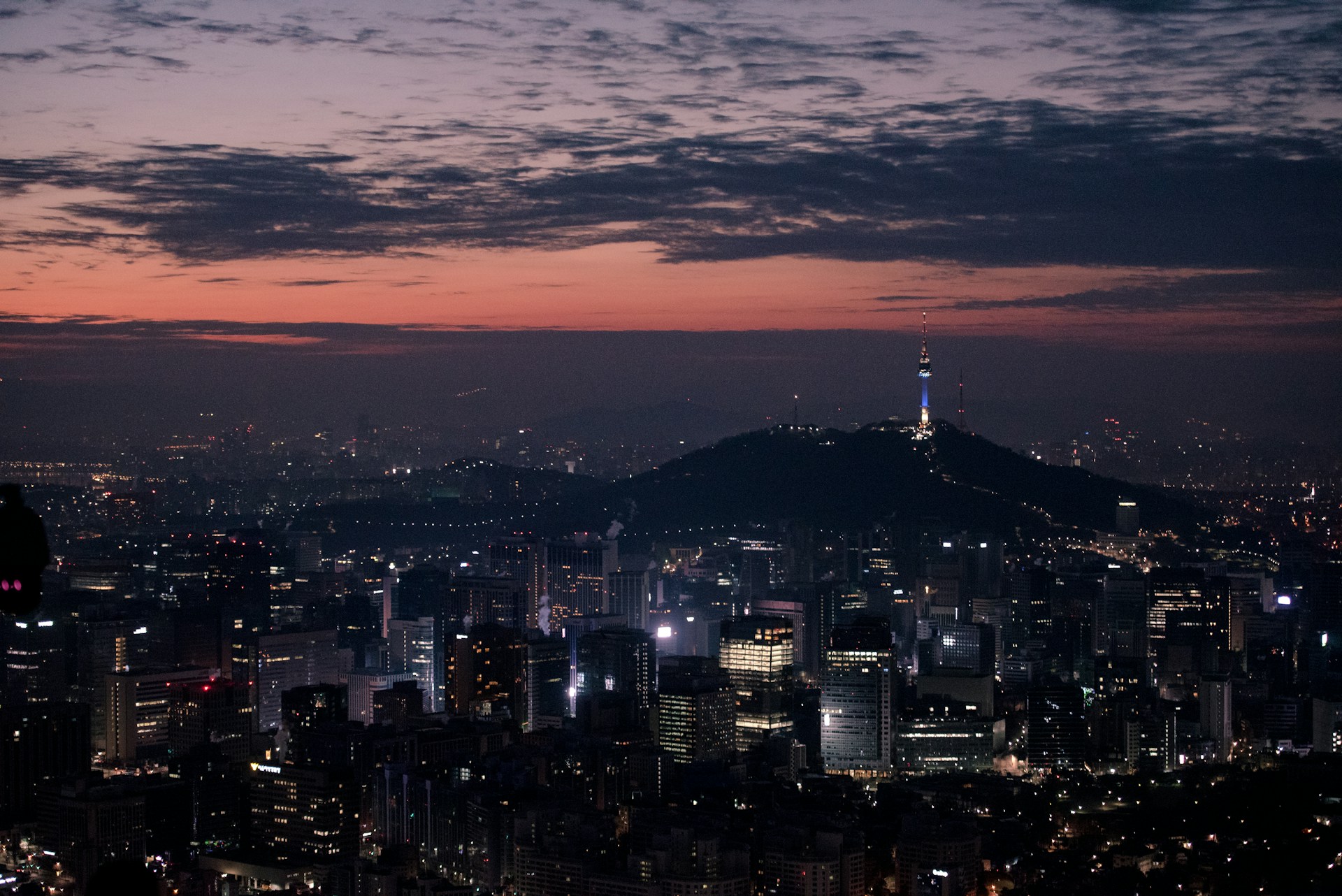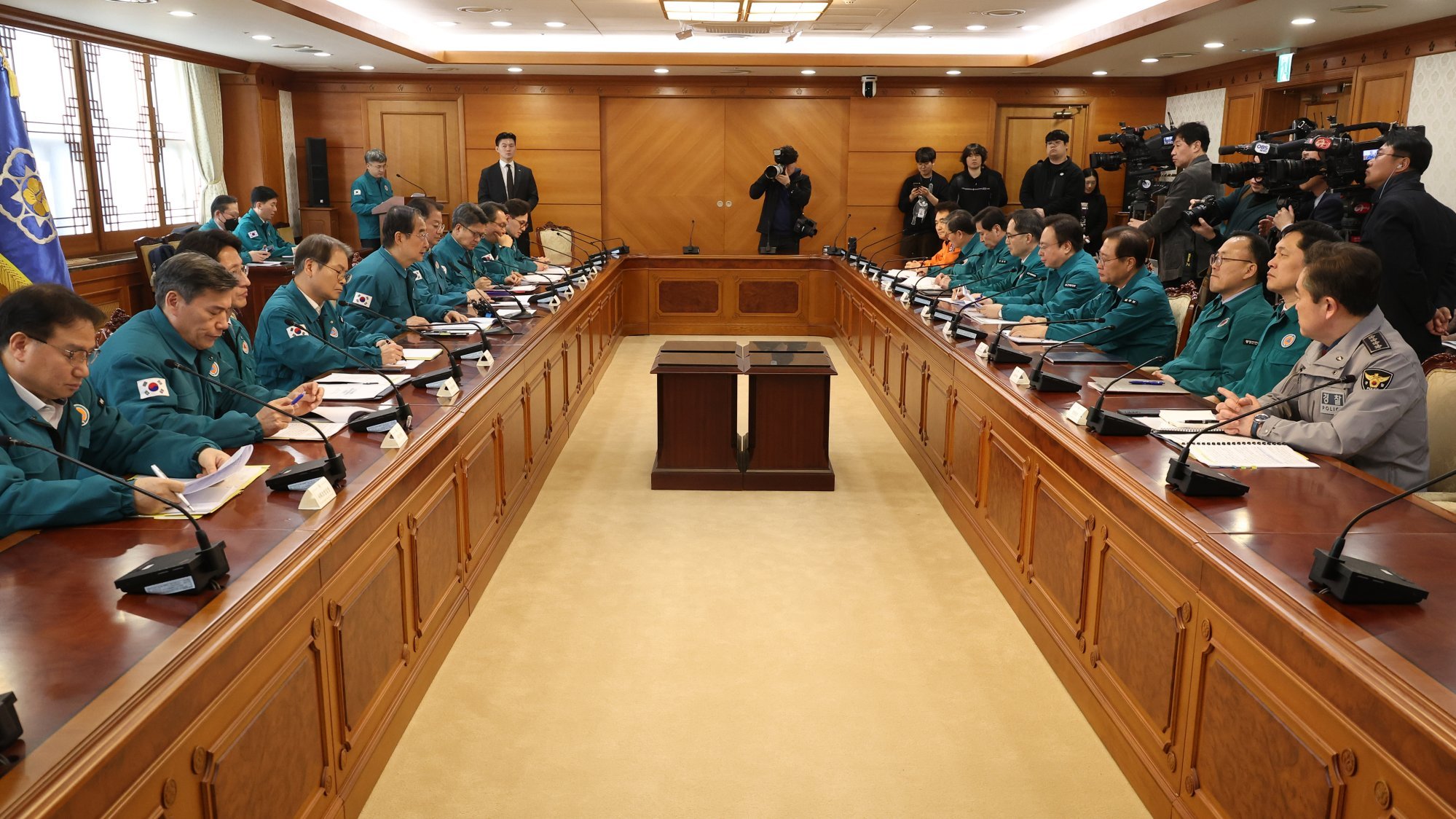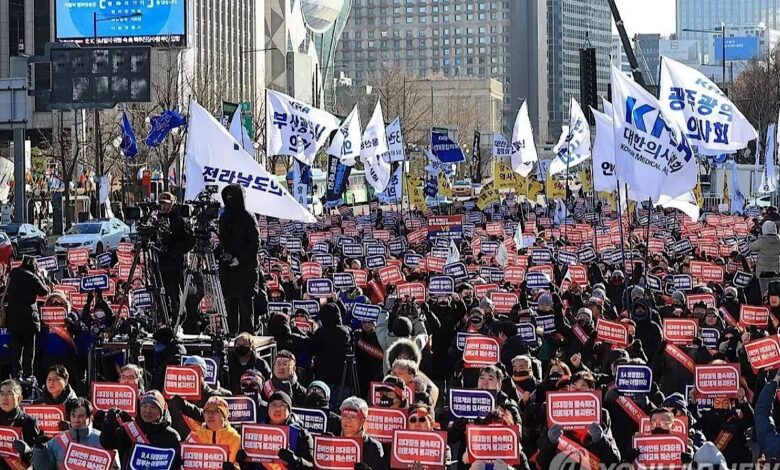The 2024-2025 South Korean medical crisis is an ongoing healthcare crisis following the announcement of new government policies that would significantly increase medical student admission quotas. Thousands of residents and interns have since resigned, resulting in medical school professors working to cover. This forced non-urgent, less complicated patients to no longer be treated at tertiary care facilities, leading to financial concerns at large university hospitals, as well as public anxiety about timely treatment.
The healthcare system struggles with doctor shortages, overworked staff, low reimbursement rates, and insufficient government support. Mass resignations, student boycotts, and protests reflect deep dissatisfaction of medical professionals. The South Korean government labeled medical professionals' advocacy as "illegal collective actions," declaring a healthcare crisis and launching a smear campaign to portray them as a self-serving cartel. This confrontational approach, reinforced by the President, undermined trust and collaboration in healthcare reform.
Background and causes
Demographic change of South Korea
In June 2012, South Korea's population reached 50 million, and by the end of 2016, the population peaked at about 51 million people. However, in recent years the total fertility rate (TFR) has plummeted, leading some researchers to suggest that if current trends continue, the country's population will shrink to approximately 28 million people by the end of the 21st century. In 2018, fertility in South Korea became a topic of international debate after only 26,500 babies were born in October and an estimated 325,000 babies for the year, giving the country the lowest birth rate in the world. In 2020, the country recorded more deaths than births, resulting in a population decline for the first time since modern records began.
In 2023, 69% of local medical centers could not fill their quota of doctors. Examples include Chungnam Seosan medical center being unable to hire enough radiologists despite offering an annual salary of 420 million won (about $300,000) with 4.5 working days per week and Gangwon Sokcho medical center increasing the annual salary of emergency medicine specialists to 420 million won ($300,000).
South Korean President Yoon Suk Yeol argued the basic medical system is collapsing, with pediatrics, obstetrics, gynecology, and other specialties lacking manpower and thus treatment being delayed. He also cited the imbalanced urban-rural distribution of medical services as a reason for the quota increase.
Government of healthcare system
The healthcare system has a mandatory designation system that integrates all doctors and private medical institutions into public health insurance, enforcing predetermined fees and rigorous audits. Low fees necessitate subsidization from non-insurance treatments or high-volume, low-margin practices, without compensating doctors for their extensive training and experience. Medical malpractice criminalization rates are extremely high, repelling young doctors from high-risk critical care. The government provides minimal support for medical education and residency training, making medical schools rely on hospital profits. Residents often work up to 100 hours a week, and university hospitals depend on cheap labor due to strict fee controls.
The government negotiates yearly with medical professional organizations about the amount of fee increase. Healthcare practitioners argue that fees are insufficient compared to other OECD countries, and government-reimbursed fees do not cover the costs. This debate has persisted for several years. Most fees are strictly government-controlled and a fraction of those in the United States, and lower than those in China and Singapore.
The insurance system with low reimbursement rates encourages high turnover in hospitals and hardly dissuades patients from second opinions. The health finance system is characterized as "low premiums, low medical consultation fees, low pay". National Health Insurance sets low medical fees, takes advantage of medical workers, and provides inadequate working conditions. This medical policy of overwork and underpay caused a shortage of medical workers in pediatrics and other specialties involving underpaid procedures.
When health insurance benefits are broadened, healthcare facilities emphasize uninsured services, due to low insurance benefit payouts. Insurance reimburses only 87% of healthcare service expenses, causing institutions deficits when providing insured services. Among OECD countries, South Korea has a low proportion of active nurses. Despite nurses increasing overall, persistent turnover kept active nurses few. Opposition to this by medical workers led to strikes and public debate. South Korea offers excellent medical services despite its low burden of public health insurance premiums. Nonetheless, patients are burdened by uninsured medical services. In addition to deficits, healthcare providers struggle with dissatisfaction and burnout under budget-constrained treatment times.
South Korean policymaking considers few professional opinions. This resulted in governance failure, with unnecessary severe conflicts among doctors, pharmacists, civil society organizations, media, and other stakeholders. One study examined how the media legitimized the government more than the doctors. The government is portrayed as "an actor that partially contributed to the cause of the conflict but is keen to exert its best efforts to resolve the problem in the best interest of the public and everyone involved in the conflict." Doctors are seen though three major news frames: the "morality frame," the "internal dissent frame," and the "inconciliatory attitude frame", and these depict them as "a group primarily motivated by economic interests, violating the ethical code of their profession, experiencing internal divisions, and refusing to engage in dialogue." Medical providers are valid in pointing out structural problems in the medical community caused by the government. Media bias is expressed in name-calling "criminals" and "murderers".
Admission quota of medical schools of South Korea
Since 2006, the admission quota of medical schools has been 3,058 per academic year. It was decreased from 3,500 in 2000, the year of another doctors' strike. The strike was about the proposed strict job separation between physicians and pharmacists, which could significantly damage doctors' income. Residents and interns refused to work, and local emergency rooms closed.
Repulsion from residents
The planned quota increase immediately caused repulsions from residents and interns, which claim the welfare of trainee doctors must be improved first. According to the Korea Intern Resident Association, interns and residents have 36-hour shifts, while the United States has less than 24-hour ones. Half of American doctors work no more than approximately 60 hours weekly, while Koreans commonly exceed 100 hours. The average resident salary is 70 million won (about $50,000). It was surveyed that 100% of thoracic surgery residents, 82% of surgery residents, and 77.4% of neurosurgeons work more than 80 hours a week. This is one of the aspects of cheap and high-quality medical care in Korea that the government has been boasting about.
Skewed distribution of doctors in South Korea
Doctors and the government posited that it is not the number of medical school admissions but government policy and healthcare laws that made the doctors move to lucrative specialties away from critical care. It is illegal for physician assistants (PA) to perform basic operations, such as suturing, as well as for tattoo artists to do tattoos, because these operations are invasive and therefore may threaten patient health. Only doctors can legally conduct skin care treatments such as via laser or neurotoxin, leaving work in the beauty market to general practitioners (medical students who have passed the Korean Medical Licensing Examination but are not doctors in training).
The core issue for local public hospitals in South Korea lies in the inherent conflict between serving the public interest and achieving profitability. They are mandated to fulfill a public mission, encompassing tasks like establishing a medical safety net for low-income individuals and managing financially unsustainable medical facilities and emergency healthcare situations. Simultaneously, they are expected to pursue profitability by delivering high-quality care through competition and operating as independent, self-sustaining entities following private business principles. The decline in inpatient revenue at local public hospitals can be attributed to several factors, including low reimbursement rates, charitable care provided to low-income individuals, and unprofitable services such as obstetrics and gynecology and pediatric services in medically underserved regions. Local public hospitals have received very little from the central government.
Resolutions and negotiations
Adjusting the increased quota
On April 19, the government offered adjusted healthcare reforms where medical schools determine their own 2025 intake admissions, lowering the designated quotas by up to 50% for 2025 while maintaining the original increased quota from 2026 onwards.
Hiring doctors from foreign countries
In May, the government planned to allow vetted foreign doctors. In response, the head of KMA, Lim Hyun-taek, posted on Facebook a screenshot of a news report of newly graduated Somali doctors captioned "Coming Soon.", suggesting foreign doctors are inferior. Although deleted, it was deemed as "racist" and "exploiting Islamophobia and stereotyping against developing countries".
The government's proposals were part of preparing the new medical environment for the upcoming multiethnic society, which is already becoming reality since foreign born people reached 2.5 million in 2024 and international marriage reached 10% in 2024. A 2010s-onwards official government program for international healthcare collaboration with Middle Eastern and African countries had over 130 Middle Eastern specialist doctors in 2024. These foreign doctors are satisfied with their hospital environment.
Reactions
Government
The crisis started on February 6, 2024. The Yoon government announced an increase in medical school enrollment by 2,000 per year from 2025, raising the quota to 5,058.
In opposition, doctors collectively stated existing doctors in major hospitals suffice. However, the government pushed forward with its plan. South Korean President Yoon Suk Yeol denied that the quota increase would degrade medical education. He stated that the proposed increase of 2,000 students is the minimum required. If the doctors did not return to work, the government will suspend their medical licenses. The government to raise the crisis level of the country's medical system to "serious". South Korean Prime Minister Han Duck-soo chaired a meeting to acknowledge a large portion of the doctors still absent. Han's government planned a budget for replacement doctors and rewards for those remaining and government committees for healthcare reforms. The Ministry implemented triage to protect regional emergency centers. It also allowed nurses some physician roles, and legalized telemedicine for all clinics and treatment centers.
The Ministry of Health and Welfare deployed military and public health doctors to affected hospitals to ensure emergency patient care. It threatened trainee doctors with license suspensions for their collective action. It tried to expand the role of nurses in emergency care units at general and training hospitals by allowing experienced nurses certain tasks assigned to doctors, such as CPR and medicating critical patients.
The Ministry suspended two Korea Medical Association leaders' licenses, ordered interns back, and issued a return-to-work order to the 13 interns and residents of the Korea Intern Resident Association committee. It offered clemency for resuming work by February 29, or before all suspension notices were sent. It threatened to persecute whoever refused to return to work by March 1 using administrative sanctions and other judicial measures. Only 565 doctors returned by March 1, and March 8 recorded absent more than 11,994 interns and residents (92% of the trainee doctors). On March 4, the Ministry announced a second inspection at 50 hospitals with the same clemency. The punishment included sanctions in employment records and a three-month license suspension delaying their physician qualification by more than a year. Suspensions affected 7,000 interns as of March 4, and 5,566 interns and residents as of March 11.
A Central Disaster and Safety Countermeasure Headquarters was established, headed by the Prime Minister, to coordinate the government's response to the crisis. Situation rooms were set up to manage the transportation of severely ill patients in major regions. The Seoul High Court ruled the quota increase is necessary for the greater good.
The Education Ministry helped prevent boycotting medical students from failing semesters due to insufficient attendance by allowing measures including:
- A year- not semester-based grading system
- Longer or shorter semesters, or three not two semesters per year
- Night, online, or weekend classes
At an August 16 National Assembly parliamentary hearing, Health and Welfare Minister Cho Kyoo-hong planned additional reforms to increase medical school admissions in early September. A martial law ordered doctors back to work from December 3 to 4.
Experts in Medicine
Medical professionals argue the plan would degrade medical education. However, the student-to-faculty ratio is 33% Germany's and 50% the United States', each Korean professor handling 1.6 students.
The quota increase will not immediately resolve manpower problems because training takes ten years. A fresh medical student becoming a specialist takes six-years studying, a one-year internship and three to four years of residency. More immediate actions such as allowing some foreign doctors are necessary.
Medical professionals also point to frequent medical malpractice litigation. Approximately 750 South Korean doctors are accused of medical malpractice every year. That is 14.7 times Japan, 580.6 United Kingdom, and 26.6 Germany. A 2019 study found one medical malpractice suit in the past 3 years per 3 doctors. More litigation occurs in emergency medicine, cardiothoracic surgery, gynecology, pediatrics, and other critical specialties. Such an indictment does not revoke licenses but still threatens these specialists.
Doctors
In late February, many doctors resigned collectively, and many medical undergraduates suspended their studies. The Ministry of Health and Welfare found 10,034 resignation letters and 9,006 resignations among interns and residents in 100 hospitals. The Korea Medical Association met at Yeouido, Han River, Seoul, condemned government pressure on doctors, and mobilized doctors to protest. Hospitals received 158 military and public health doctors. Senior doctors and professors from 20 hospitals planned to resign on March 25 in solidarity, but only started working reduced hours on that day. Protesting residents had only 8.4% returning by July 18, and were terminated on July 15. To fill vacancies, 7,645 residents started being recruited from teaching hospitals for the rest the year.
Associations
The Korea Medical Association stated that the right to resign is constitutionally protected. The Korea Intern Resident Association opposed the quota increase and return-to-work order. In May, the quota increase was reduced from 2,000 to 1,500 for one upcoming academic year. This followed updated numbers from universities wanting a lower quota for conflict resolution between professors and other faculty. However, the Korea Medical Association (KMA), residents and interns maintained their stance.
The Korean Health and Medical Workers' Union voted in favor of a general strike with 91% of workers across 61 hospitals in support. This was in response to furloughs, unpaid leave, mandatory overtime, and other hospital austerity emergency measures. It was called off after negotiations with hospitals for pay raises and improved working conditions.
Students' boycott
Students began to boycott their classes from February 20. Gachon University postponed the start of the semester from mid-February to March 4 then March 25, and Gyeongsang National University to March 15. Leave applications numbered 5,401 (28.7%), increasing to over 14,000 when including improperly filed applications. Only 495 of 19,345 students (2.6%) returned by July. Attendance rates varied, with first-year pre-med at 1.7% and seniors at 3.5%. Government concessions have not significantly increased attendance.
Media
President Yoon gave an hour-long nation address to reaffirm the quota increase and appealed to the public:
As the president, I regret not being able to promptly address the public inconvenience ... All rational people will agree that the country faces a shortage of medical doctors.
The government labeled the collective criticism and social advocacy of medical students, residents, and doctors as "doctors' illegal collective actions," declaring a national healthcare crisis of the highest risk level. The "Central Disaster and Safety Countermeasures Headquarters for Doctors' Collective Actions," led by the Prime Minister, was established. The Emergency Response Headquarters conducted daily public briefings, marking an unprecedentedly swift governmental response. Pro-government advertisements featured the President's commitment, and included promotional videos in movie theaters displays on public buses and subways. Screens inside apartment elevators criticized "emergency room ping-pong" and "pediatric clinic open run". Doctors and the medical community were villainized as a self-serving cartel, a characterization cemented by the President in a national address. This was confrontational not collaborative in healthcare reform, undermining the trust in the doctor-patient relationship.
Patient groups
Patient groups feared continuing conflicts between the government and the doctors. In July, 92 patient groups including the Union of Korea Breast Cancer Patients, Korea Alliance of Patients Organization and Korean Organization for Rare Diseases advocated stopping the collective actions and prohibiting patient-hostile actions.
Opposition parties and the public
Democratic Party politician Lee Jae-myung opposed doctors and supported the quota increase. Cancer and ALS patient groups and Korean Buddhist order Jogye Order called for the quick return of doctors.
A February Gallup poll indicated 76% supporting the 2,000 quota increase and 16% opposing. A March Gallup poll indicated 49% considering the government response inadequate compared to the medical community's opposition to expanding medical services.
Impact
Severance Hospital, Seoul National University Hospital, and many other hospitals were forced to cancel or postpone many surgeries. Some hospitals shortened operation durations or prioritized critically ill patients.
An ophthalmology professor in his 40's died of brain hemorrhage on March 24, and an internal medicine professor in his 50's died of intestinal obstruction on April 20. This raised concerns about health risks to overworked medical school professors covering for resigning residents.
See also
- Healthcare in South Korea
- 2024 in South Korea
References



